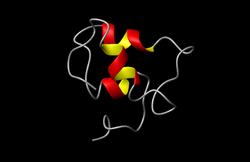Difference between revisions of "IGF-1 - Anatomy & Physiology"
| (4 intermediate revisions by 2 users not shown) | |||
| Line 1: | Line 1: | ||
| + | {{OpenPagesTop}} | ||
==Overview== | ==Overview== | ||
| Line 5: | Line 6: | ||
2007 '''Schematic structure of Insulin-like growth factor-1.''']] | 2007 '''Schematic structure of Insulin-like growth factor-1.''']] | ||
| − | IGF-1 is one of a number of | + | IGF-1 is one of a number of insulin-like growth factors. Insulin-like growth factors are produced by many different tissues and have local paracrine and autocrine effects. (see [[Hormones - Anatomy & Physiology|hormones]] for further details). They bind to carrier proteins to extend their half life in the blood. The [[Liver - Anatomy & Physiology|'''liver''']] is the main source of IGF-1. Hormones that directly stimulate Insulin-like growth factor-I (IGF-I) include growth hormone, insulin and oestradiol.Growth hormone is the main regulator of IGF-I production in the liver and insulin and oestradiol are stimulatory in other tissues. |
==Actions of IGF-1== | ==Actions of IGF-1== | ||
| Line 11: | Line 12: | ||
Increased '''protein synthesis''' and increased '''chondrogenesis''', both promoting growth. | Increased '''protein synthesis''' and increased '''chondrogenesis''', both promoting growth. | ||
| + | |||
| + | {{OpenPages}} | ||
[[Category:Endocrine System - Anatomy & Physiology]] | [[Category:Endocrine System - Anatomy & Physiology]] | ||
| − | [[Category: | + | [[Category:A&P Done]] |
Latest revision as of 17:08, 8 December 2016
Overview
IGF-1 is one of a number of insulin-like growth factors. Insulin-like growth factors are produced by many different tissues and have local paracrine and autocrine effects. (see hormones for further details). They bind to carrier proteins to extend their half life in the blood. The liver is the main source of IGF-1. Hormones that directly stimulate Insulin-like growth factor-I (IGF-I) include growth hormone, insulin and oestradiol.Growth hormone is the main regulator of IGF-I production in the liver and insulin and oestradiol are stimulatory in other tissues.
Actions of IGF-1
Increased protein synthesis and increased chondrogenesis, both promoting growth.
Error in widget FBRecommend: unable to write file /var/www/wikivet.net/extensions/Widgets/compiled_templates/wrt66f4e917d5ee24_05131224 Error in widget google+: unable to write file /var/www/wikivet.net/extensions/Widgets/compiled_templates/wrt66f4e9181166a8_49578921 Error in widget TwitterTweet: unable to write file /var/www/wikivet.net/extensions/Widgets/compiled_templates/wrt66f4e9182e3171_12284360
|
| WikiVet® Introduction - Help WikiVet - Report a Problem |
